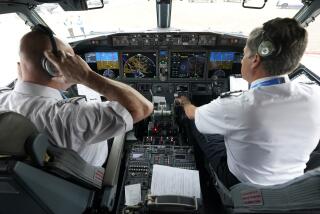Arming Pilots Is the Best Way to Get Air Security
- Share via
His timing wasn’t the best.
The morning after U.S. Transportation Secretary Norman Y. Mineta announced that he opposed letting airline pilots have guns to guard their cockpits--though he might consider stun guns--the Washington Post reported “a declining number of federal air marshals are aboard flights using Reagan National Airport.”
Despite repeated promises that all flights into the capital, with its many vulnerable targets, would be guarded, pilots say the true number is “quite a bit less than 100%” and falling.
Worse, while the exact number of marshals has not been made public, the same news report claimed that there were fewer than 1,000 across the nation, and only a fraction of those were available on any given day. With most marshals apparently working in pairs, less than 1% of the 35,000 daily commercial flights in the U.S. are being protected--hardly what we had hoped for six months after Sept. 11.
With increased preflight screening and passenger awareness, it may be harder today for terrorists to take over a plane. But the reward for terrorists also would be higher. Another successful attack would destroy confidence in air travel. The airlines still are suffering massive losses. And while Mineta’s decision to rely on screening passengers, strengthened cockpit doors and air marshals to prevent terrorism is a good start, it is not enough.
Inspections are hardly perfect. Again, the day after Mineta’s announcement, security was breached at Connecticut’s Bradley International Airport, forcing a plane in mid-flight to return to the airport and have its passengers sent through metal detectors a second time.
In recent weeks, knives, box cutters and long scissors have regularly made it through security. As accused shoe bomber Richard C. Reid demonstrated in December, tiny amounts of military explosives such as C4 are easy to hide.
When screening fails, armed marshals can help prevent hijackings. Bill Landes at the University of Chicago found that between a third and half of the drop in airplane hijackings during the 1970s could be attributed to two factors: the introduction of armed U.S. marshals on planes and the increased ability to catch and punish hijackers.
But the process of recruiting enough marshals is slow and expensive.
The marshals program would cost $10 billion per year and “require a work force the size of the U.S. Marine Corps” to cover most planes, according to the pilots’ unions. Not only does it take a long time to attract and train enough new marshals, but the program has had a problem with retention. According to the Federal Aviation Administration, marshals are finding the job incredibly boring as they fly back and forth across the country, waiting for something to happen.
And the marshals program doesn’t guarantee safety. Osama bin Laden’s organization was able to put five hijackers on each of three planes and four on a fourth. With enough hijackers on a plane, they could overpower two marshals.
Nor does strengthening cockpit doors guarantee safety. Doors can be blown open. Security can be breached, and terrorists could get the keys or codes used to open the doors.
So what else can be done? One choice is to arm pilots as a last line of defense. Their job is not to police the entire airplane but the much more limited and relatively simple task of defending a single narrow entrance to keep terrorists out of the cockpit.
Of the two pilots unions, 83% of the Allied Pilots Assn. and 73% of the Air Line Pilots Assn. support arming pilots. Seventy-eight percent of the nonunionized Southwest Airlines Pilots’ Assn. feel the same way. More than 70% of the pilots at the major airlines have served in the military and are familiar with guns. They know more about their planes than the marshals.
All three pilots groups have agreed to training programs before being armed.
Stun guns are not a serious alternative. The New York Police Department found that stun guns fail to fell suspects 30% of the time because of thick clothing or rubberized shoes. Fears of bullets piercing the airplane’s skin and causing it to lose pressure are misplaced. Specialized bullets are designed not to penetrate the airplane’s aluminum skin. And even if a regular bullet penetrated the skin, there is unlikely to be any noticeable change; an air outlet at the back of the plane, which draws the air through the cabin, would automatically shrink to a smaller size to compensate.
Banning guns does not ban violence. It is the law-abiding citizens who obey these rules, not the terrorists.
More to Read
Sign up for Essential California
The most important California stories and recommendations in your inbox every morning.
You may occasionally receive promotional content from the Los Angeles Times.













